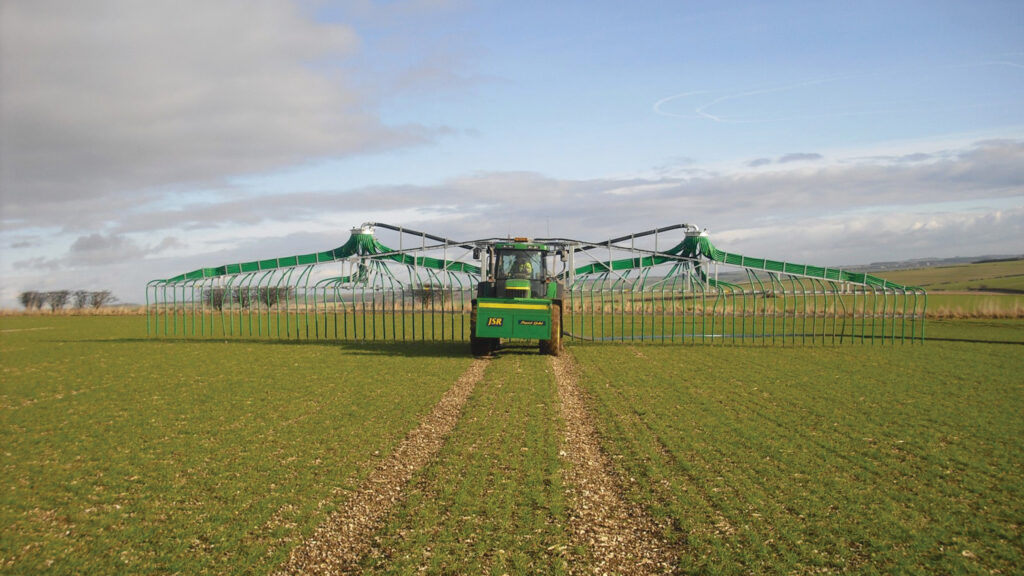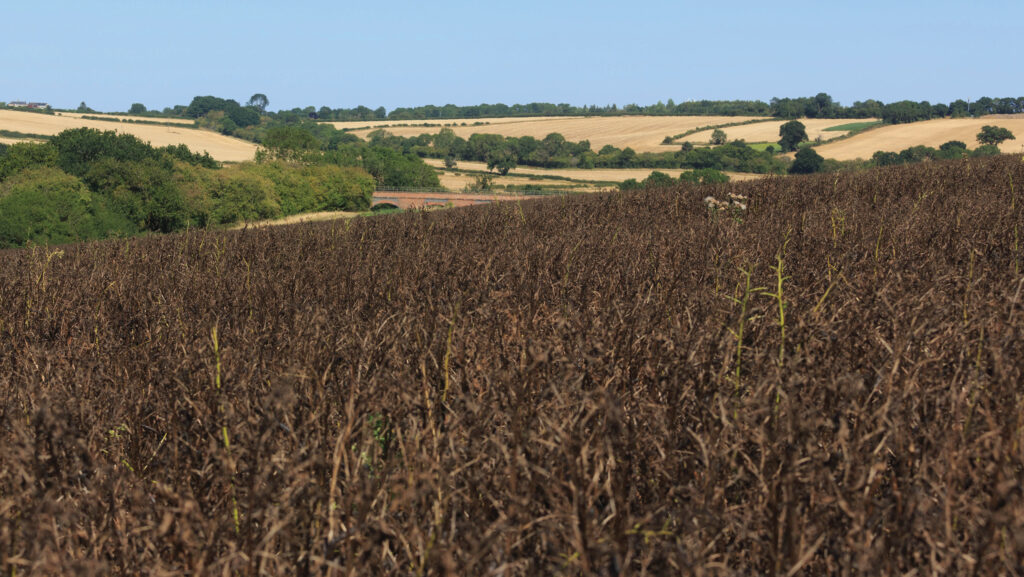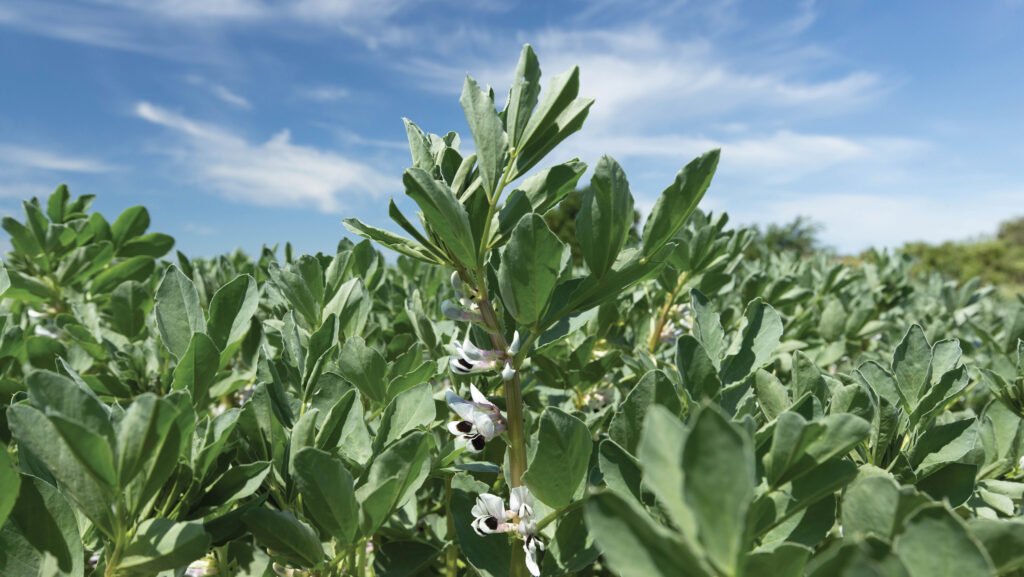How a Yorkshire pig and arable setup is cutting carbon
 © JSR Farms
© JSR Farms Home-grown beans have replaced 50% of the soya bought in for finisher rations, and slurry additives have cut ammonia emissions by more than 10% in ongoing trials at an East Yorkshire mixed farming company.
JSR Farms closely integrates arable and pig enterprises. The pig operation is spread across multiple units and sites, with more than 3,000 commercial sows for finishing, and 800 high-health nucleus sows producing breeding stock for sister business JSR Genetics.
See also: Feed and slurry key to pig producers’ emissions reduction
While sustainability has been a core ethos of the farm since its inception, a carbon audit carried out five years ago has helped drive ambition to reduce the farm’s footprint, explains technical manager Alex Haigh.
“We first started trialling carbon calculators back in 2019. I trialled all that were available at the time that suited livestock, and would allow integration with the arable side of the business and our feed mill,” she says.
The business opted for Agrecalc. Since then, the farm has benchmarked every year, analysed the results and used them to draw up an action plan of areas to focus on across the business in a bid to continually bring down the overall footprint.
“Something we found is that the quickest and easiest improvement methods to implement are arable related, but the biggest improvements [to our carbon footprint] will come from reducing livestock emissions,” notes Alex.
As such, cutting relevant pig emissions is currently focused around genetics, feed, slurry management and renewable energy.

© Tim Scrivener
Genetic improvement
JSR Genetics supplies stock to the business. “We’re partnered with leading swine genetics company Topigs Norsvin, renowned for their research and innovation – we implement their genetics here in the UK,” explains Alex.
“The ability of the business to breed for specific traits to improve pig production efficiency is a significant contributor to an improved outlook for emissions.
“We’ve got three dam line breeds: the Z-line, the L-line and the TN70. The TN70 is promoted as the best sow across all farming setups, both indoors and outdoors.
“We’ve also got three sire lines: the TN Tempo, the TN Duroc, and the GC400 Hampshire, our one non-Topigs Norsvin breed. Combinations of these breeds produce exceptional performance for cost-effective, efficient pig production.”
Alex adds that the business has a nucleus farm that breeds the Z-lines and the TN70s, with their genetic programme controlled and monitored in-house by herself and a colleague, utilising Topigs Norsvin advice.
“Genetic improvement of these breeds has a focus on improving efficiency, which in turn reduces our carbon emissions.
“Some of the traits with a specific improvement focus include mothering ability, feed conversion rate, robustness and survivability.”
Home-grown feed
The majority of the 4,000ha (9,884 acres) is planted with wheat, barley and rye, which go directly into pig diets through the on-site feed mill.
With feed contributing about two-thirds of carbon emissions in pig production, according to Alex, making use of home-grown cereals in JSR’s own feed mill tackles feed-related emissions associated with grain haulage and processing.
Growing the crops using minimum tillage also helps: “We’re roughly 50% self-sufficient in raw materials for the pig rations,” she says.
However, soya is still a major component of pig diets, and often reckoned to be one of the biggest causes of emissions in pig farming.
Alex says JSR is exploring options to reduce the inclusion level of soya: “We’re currently trialling beans in our already lowered protein finisher diets, replacing about 50% of the soya with beans.
“We’ve done three batches of 2,000 pigs so far,” she says, adding that a further three batches of 2,000 are ongoing.
“The aim is to do three sets of trials to analyse output before rolling it out across the units. From what we’ve seen so far, we’re maintaining the same, or achieving better, performance from the pigs.
“Hopefully, once we’ve rolled that out – and if it continues to be a success – we’ll look at incorporating beans into other diets.”
Slurry management
Solid muck and slurry from the pigs are used to reduce reliance on artificial fertilisers in the arable rotation.
“We refer to the slurry as liquid gold. It has so many benefits – soil structure, organic matter and soil health to name a few,” says Alex.
The business has run a series of trials to see if it is possible to make this muck more environmentally friendly.
The most recent one involved incorporating an additive in the slurry store to reduce ammonia emissions from one of the finisher units.
Digest-it works by breaking down the slurry organic matter in such a way that the bacteria releases less ammonia, she explains.
To measure this, the team carried out ammonia test monitoring using Draeger gas detection tubes, over two periods of six months, and found that by incorporating the additive, ammonia was reduced by 12%.
Once other trials have been completed, JSR plans to use the additive routinely to maintain this reduction.

© Tim Scrivener
Renewable energy
Generating electricity is another way the business keeps a lid on emissions, with wind, solar and biomass energy all produced on farm.
Two 80kW wind turbines – named Pinky and Perky – produce about 80% of the electricity for the pig and arable operations at the main farm site, says Alex.
“Since auditing our pig sites, we have been able to reduce our energy usage by 10% over the past two years, now with better control measures in place to monitor our consumption.”
Improvements were made by increasing staff awareness of areas where energy was being wasted, such as leaving lights on when not needed.
Installing thermostats, LED lighting and sensors has also helped cut energy usage, as has ensuring temperature control is running efficiently and upgrading to more efficient and controllable heaters where needed.

